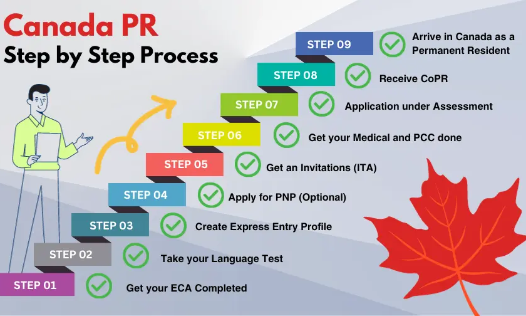Payment is being processed. Please do not refresh or close this page until your payment is complete.
 Book an Appointment
Book an Appointment

For many foreign nationals seeking Canadian permanent residency (PR), the Provincial Nominee Program (PNP) may be the most suitable pathway.
As of the time of writing, the federal Express Entry system has 236,909 profiles, and the most recent CRS cut-offs for CEC draws in 2025 have ranged between 521 and 542.
If you don’t have a high CRS score or qualify for category-based draws, the PNP may be your best shot at gaining Canadian PR through economic immigration.
This article will cover
• How you can obtain Canadian PR through the PNP;
• How to be considered for provincial nomination;
• What criteria PNPs look for in candidates; and
• The costs associated with applying for a PNP.
How does getting PR through the PNP work?
Obtaining permanent residency through the PNP is a two-step process.
First, you must obtain a provincial nomination.
After obtaining a provincial nomination, you’ll apply for PR to the Canadian federal government’s immigration department, Immigration, Refugees, and Citizenship Canada (IRCC).
To obtain a provincial or territorial nomination, you must demonstrate an intent to reside in the province or territory nominating you, in addition to fulfilling the requirements of the particular PNP stream.
How to pursue provincial nomination
To pursue a provincial nomination, you must meet the eligibility requirements for one of the PNP streams, and you must follow the process to be considered for that stream.
How to determine which streams you are eligible for
There are over 80 PNP pathways. To determine which pathways you are eligible for, you must do your own research, or consult with an experienced immigration representative.
In all cases, you will need to demonstrate an intent to reside in the province or territory from which you seek a nomination.
Once you’ve determined that you’re eligible for a pathway, the next step is to follow the consideration process for that pathway.
Base vs enhanced streams
Enhanced PNP streams are integrated with the federal Express Entry system. To be eligible for an enhanced stream, you must always have a valid Express Entry profile, in addition to meeting all other stream requirements.
Base PNPs do not integrate with Express Entry.
The distinction between base and enhanced streams is relevant in three ways:
• Eligibility – what you need in order to qualify for a given stream.
• Consideration – the process(es) followed to be considered for provincial nomination under that stream.
• Post-nomination – the process(es) by which you can expect to obtain PR after having received a provincial nomination.
Eligibility
The eligibility criteria you will be required to meet will differ depending on whether you’re applying to a base or enhanced PNP stream.
For both base and enhanced streams, typical eligibility criteria include, but are not limited to
• Age;
• Education;
• Job offer;
• Language proficiency; and
• Work experience.
In the case of enhanced PNP streams, you will need to meet additional criteria.
Enhanced streams
Enhanced streams are linked to the Express Entry system and are overseen on a federal and provincial level.
In order to qualify for an enhanced PNP stream, you must have an active Express Entry profile and meet the eligibility criteria for one of the following federal programs:
• Canadian Experience Class (CEC);
• Federal Skilled Worker Program (FSWP); or
• Federal Skilled Trades Program (FSTP).
The above programs all require a skilled occupation (NOC TEER 0, 1, 2, or 3), so if your NOC is TEER 4 or 5, you cannot qualify for enhanced PNP streams.
You will also need to meet the settlement funds requirement for Express Entry based on the size of your family, unless you meet one of the exemptions for settlement funds (e.g. qualifying for CEC, having arranged employment and Canadian work authorization).
Express Entry also requires you to have on your profile
• Approved language test results; and
• Educational Credential Assessments (ECAs) for any degrees.
The primary benefit of enhanced streams is faster processing time for your PR application after you receive a nomination and apply to the federal government for PR—typically 6 months for enhanced streams, compared to 12 months for base streams.
Base streams
Base PNP streams are managed by the province or territory, independently from the federal Express Entry system.
You do NOT need to have an Express Entry profile to qualify for a base PNP stream. As a result,
• You don’t need to meet the eligibility criteria for one of the three Express Entry-managed programs;
• You don’t need to have a TEER 0, 1, 2, or 3 occupation (unless required by the PNP stream);
• You don’t need settlement funds (unless the PNP stream itself requires them).
You also don’t need language tests results or ECAs to be considered for many base PNPs, although you’ll typically need these at the application stage.
Some PNP streams have both a base and enhanced option.
Consideration
The province or territory is responsible for determining the consideration process for each of their streams, and this process can vary depending on whether you want to be considered for a base stream or enhanced stream.
For base PNP streams, the consideration process will always be active, meaning you are required to take an action of some kind for the PNP to consider you as a candidate.
Source: https://www.cicnews.com/2025/04/how-to-get-canadian-permanent-residency-through-the-provincial-nominee-program-0452904.html#gs.ljrsl6